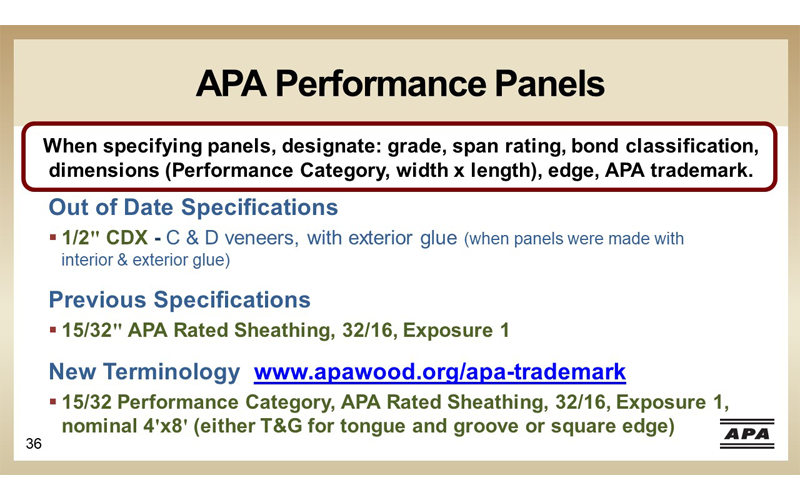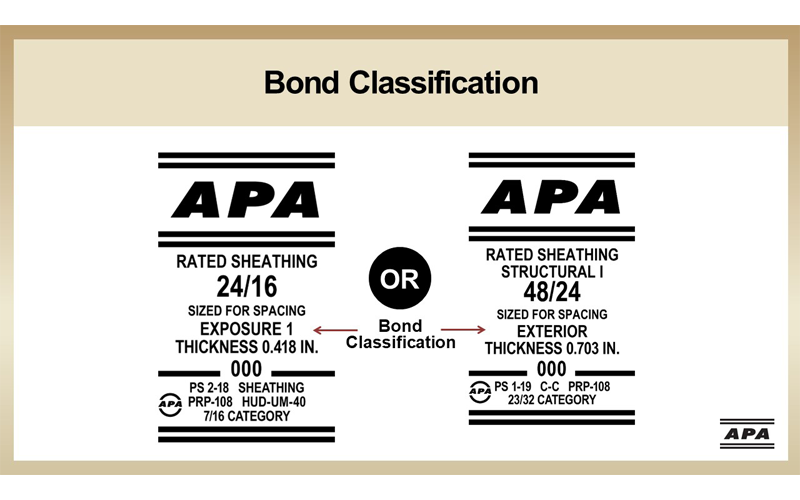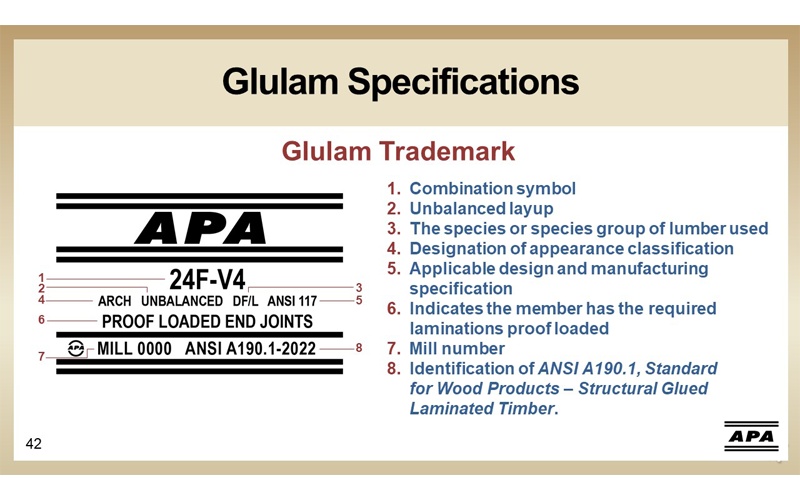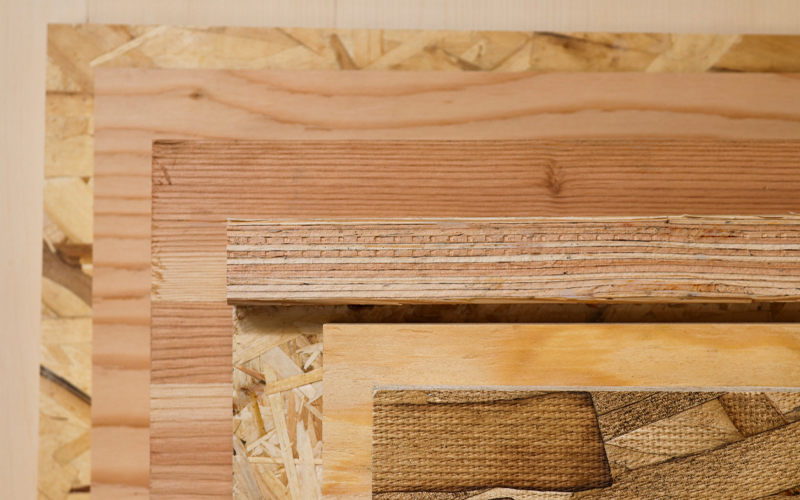Engineered wood products (EWPs) are used in a wide range of construction applications. For low in-place cost, versatility and superior performance, engineered wood systems are simply hard to beat. Their various sizes and dimensions mean less construction jobsite waste and lower disposal costs. In completed buildings, they store carbon and deliver decades of strong, dependable structural performance.
Engineered wood products comprise three primary categories:
- Panel products: Wood structural panels (OSB and plywood), including construction sheathing and sanded panels, siding, and specialty panels (including radiant barrier sheathing, concrete form panels, industrial specialty panels and overlaid panels).
- Framing products: I-joists, structural composite lumber (laminated veneer lumber, laminated strand lumber, parallel strand lumber and oriented strand lumber) and glued laminated timber (glulam).
- Mass timber products: Cross-laminated timber (CLT), mass plywood panels (MPP), glulam and structural composite lumber (SCL).
Engineered wood products that bear the APA trademark are manufactured in accordance with APA or national standards. The trademark is the manufacturer’s assurance that the product conforms to the standards noted on that trademark. APA members commit to a rigorous program of quality inspection and testing. Some EWPs are proprietary and use proprietary engineering service reports and APA Product Reports for their code recognition and product use and design information.
Below is a look into a few major engineered wood products and specification factors to consider.
Wood Structural Panels
OSB and plywood, referred to as “wood structural panels” in the code, are manufactured with an alternating layer direction using moisture-resistant adhesive. The panels must pass wet and dry structural performance tests. Panels are available in Exterior and Exposure 1 bond classifications.
Building codes require wood structural panels for application in the U.S. to comply with either the PS 1 Voluntary Product Standard, a standard that establishes requirements for structural plywood, or the PS 2 Voluntary Product Standard, a performance-based standard that establishes requirements for both OSB and plywood.
Specifying Wood Structural Panels
Specifiers should refer to APA’s Engineered Wood Construction Guide.
Tips for writing the spec:
- Use “wood structural panel” rather than OSB or plywood.
- Call out panel “Performance Category” rather than thickness.
- Avoid the term “CDX.” Instead, use “rated sheathing,” which refers to both plywood and OSB.
When specifying panels, designate the grade, span rating, bond classification, dimensions (Performance Category, width and length), and APA trademark.
Example Specification:
15/32 Performance Category, APA Rated Sheathing, 32/16 (span rating), Exposure 1, nominal 4’x8’ (either tongue-and-groove or square edge).


Exposure 1 panels are appropriate for applications that will be covered with finished materials. Exterior bond classification is used when the panel is going to be permanently exposed (like siding and concrete forms).
Structural I provides higher lateral resistance in engineered shear walls and diaphragms, most commonly needed where the panel strength axis will be installed parallel to supporting members, such as in panelized roof applications.
Other Considerations:
- 1/8” gap on all panel edges to accommodate expansion.
- Fasteners installed 3/8” from panel edges.
- The APA trademark on the panel should reflect what’s specified in the plans.
- Find wet weather tips in APA publication FAQs: Questions About Wood Structural Panel Exposure to Excessive Moisture.
Glued Laminated Timber
Glulam is made with layers of 1-1/2” and 1-3/8” lumber face-bonded together by adhesives. The wood grain runs parallel to length. Glulam can be used for beams, headers and columns and is available in I-joist-compatible depths and lengths up to 60 feet. Glulam can be custom made in just about any shape or length.
Balanced or Unbalanced Members
Unbalanced are primarily for simple span applications and include “TOP” for proper placement. Balanced are used in applications of long cantilevers or continuous spans.
Glulam can also be used in column applications. See APA’s Design of Structural Glued Laminated Timber Columns.
Allowable Design Properties:
Bending stresses are typically specified on the basis of the maximum allowable bending stress of the member. Combinations are found in ANSI 117, Standard Specification for Structural Glued Laminated Timber of Softwood Species, used by APA glulam manufacturers for design stresses. Some can also produce glulams to ESR-1940. Some manufacturers have APA Product Reports for proprietary and commodity glulam layups.
Appearance Classifications:
Architectural, Industrial, Industrial-L, Framing, Framing-L. See APA Technical Note: Glulam Appearance Classifications for Construction Applications.
Outdoor Applications:
If glulam members are covered by a roof or other overhead weather barrier and the sides and ends are not subject to direct wetting from precipitation, the application is not considered as exposed. In that case, preservative treatment or naturally decay resistant species are not required.
Glulam subject to long-term direct exposure should be pressure preservative treated or produced from the heartwood of a naturally durable species like Alaska yellow cedar or Port Orford cedar. See APA Technical Note: Preservative Treatment of Glued Laminated Timber.
Exposed glulams can also be designed for one-hour or two-hour fire exposure. See ANSI 117-2020, Section 5.7, Fire-Resistive Construction and APA Technical Note: Calculating Fire Resistance of Glulam Beams and Columns.
Glulam Specification
When specifying glulam, refer to APA’s free Engineered Wood Construction Guide and ANSI A190.1-2022: Product Standard for Structural Glued Laminated Timber.
The APA glulam trademark contains several critical pieces of information you should know when specifying beams. The trademark identifies:
1. Allowable design stress
2. Appearance classification
3. Grading – Visual (V) or Mechanical (E)
4. Assigned combination number of lumber used to assign the design stresses
a. Shear, Modulus of Elasticity, etc.
5. Wood Species: Commonly Douglas fir (DF) or Southern pine (SP)
While many stress classes are listed in ANSI 117, the most commonly available stock beam or column combinations are:
- Glulam beams: 24F-V4/DF, 24F-V8/DF, 24F-V3/SP, or 24F-V5/SP
- Glulam columns: Combination 2/DF or Combination 47/SP
- High-strength glulam beams: 30F-E1/SP or 30F-E2/SP

The trademark shown here tells us the allowable bending stress is 24F, which represents the allowable bending stress of 2,400 psi. The V tells us that the lumber used in this glulam were visually graded. The number 4 is the recipe for how the lumber layers were laid up, which is relevant only to the manufacturer. The trademark also tells us the appearance grade, whether balanced or unbalanced, the wood species, if it is cambered and the mill number.
Cross-Laminated Timber
Cross-Laminated Timber (CLT) can be considered a wide beam or panel, with strength in two directions. CLT can be used as a structural member for walls, floors and roofs. The large-scale, prefabricated solid engineered wood panel consists of an odd number of layers (usually 3 to 7) of kiln-dried lumber stacked in alternating directions, bonded with structural adhesives and pressed to form a solid, straight, rectangular panel. Board thicknesses vary between 5/8” to 2”, and widths from 2.4” to 9.5.”
CLT panels are exceptionally stiff, strong and stable, handling load transfer on all sides. Panels can include precision cuts using state-of-the-art CNC (Computer Numerical Controlled) routers. Finished panels are typically 2-10 feet wide with lengths up to 60 feet and thickness up to 20 inches. Wider widths and lengths are possible. Check with each manufacturer, as transportation restrictions might dictate size.
CLT offers superior acoustic, fire, seismic and thermal performance, is fast and easy to install, generates almost no on-site waste and offers design flexibility and low environmental impact. For these reasons, CLT is proving to be a highly advantageous alternative to materials like concrete, masonry or steel, especially in multifamily and commercial construction.
2021 IBC has expanded acceptance of CLT including buildings up to 18 stories. CLT in taller structures pertains to the requirements of the standard.
- Adhesives are required to be evaluated to ASTM D7247, Standard Test Method for Evaluating the Shear Strength of Adhesive Bonds in Laminated Wood Products at Elevated Temperatures.
- Moisture durability: Face-bond criteria is the same as glulam.
- Fire performance: Per the National Design Specification for Wood Construction (NDS) Chapter 16 including adhesive heat durability of PRG 320. New adhesives qualified to ASTM E119, and full-scale Compartment Fire Test specified in the standards.
Specifying CLT
To specify CLT, refer to APA’s free Engineered Wood Construction Guide, ANSI/APA PRG 320: Standard for Performance-Rated Cross-Laminated Timber (basic CLT grades) and APA Product Reports (custom CLT grades).
It is recommended that for custom products, a manufacture is pre-chosen in order to develop the most efficient design incorporating all of the capabilities of the product.
To learn more about specifying engineered wood products, including more on CLT, how to specify SCL and I-joists, and specification for using engineered wood in Type III buildings, view APA’s on-demand webinar, How to Specify Engineered Wood. The webinar is free to view and offers AIA and ICC credit.






